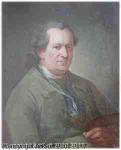Carl Gustaf Pilo
Carl Gustaf Pilo
Rođen: 1711
Smrt: 1793
Biografija:
Carl Gustaf Pilo was a Swedish-born artist and painter, one of many 18th-century European artists who had to leave their own country in order to make a living. Pilo worked extensively in Denmark as a painter to the Danish Court and as professor and director at the Royal Danish Academy of Art (Danish: Det Kongelige Danske Kunstakademi), as well as in his native Sweden. Carl Gustaf is most famous for his masterly painting, "The Coronation of Gustaf III" commissioned by King Gustav III of Sweden.
He was born on the farm Göksäter in Runtuna Parish near Nyköping, Södermanland to painter Olof (Oluff) Pilo (Pijhlou) and Beata Jönsdotter Sahlstedt.
Early information about his career contains many inconsistencies, on account of disagreements between two sources contemporary with his life. In spite of his father's protests Carl Gustav chose to be educated as a painter instead of receiving a book education. He probably received his early training from his father, who had earned his living as a young man as a decorative painter at Drottningholm and Stockholm Palace, although other indications say that he was trained by a painter named Crisman in Stockholm, Sweden. Training for Pilo would have begun in Stockholm as early as 1723.
Pilo’s career began as a craft painter. He became an apprentice in 1731. According to Anton Friedrich Büsching (1754) Pilo traveled through Germany to Vienna 1734-36; this however is contradicted by Thure Wennberg (1794) who insists that Pilo never traveled out of Scandinavia but instead was a student at the newly established Swedish Drawing Academy in 1735. He probably worked as a craft painter between 1733 and 1738.
He lived 1738-1741 in Scania where he may have worked as a craft painter for two Scanian noble families, the Lewenhaupt family and the Baron Malte Ramel family. Pastoral drawings of his from this time indicate that he may have painted decorations at some estate. He was reputed to be a competent portraitist, and is reported to have painted a large family picture for the widow Countess Lewenhaupt.
He became betrothed to Eva Maria Malmgren of Hofterup (between Malmö and Landskrona), a churchwarden’s daughter, in 1738. During these years in Skåne he also made portraits, although it is not evident from the quality of his work that he ever received professional instruction at this point in his career.
In early 1741 when marriage to Malmgren began to loom, Pilo left Skåne, Scania in English, and moved to Copenhagen, Denmark. There is some question as to whether he left his fiancée behind in Sweden in a childbearing state. In any case Pilo refused to marry her, and the engagement first became legally annulled on 5 May 1747.
He brought with him to Denmark a letter of introduction from Charlotte Amélie Dorothée Desmarez, governess at the Ramel residence and his future wife, to her brother-in-law C.G. Almer, language teacher at the National Cadet Academy (Landkadetakademiet) in Copenhagen. He started working as drawing teacher at the Academy on 4 April 1741, teaching the sons of Danish nobility, the royal pages and cadets.He became at that time a favorite of Admiral Count Danneskjold.
He continued his career as a portraitist in Denmark. He painted an enthusiastically received portrait of Crown Princess Louise of England, the wife of the future Frederick V, one of centenarian Christian Jacobsen Drakenberg in 1742, at the acclaimed age of 116, and another of Christian Lerche in 1743. He concentrated on developing his craft during the 1740s, and probably drew from model in 1744. His duties soon expanded at the Academy; when on 28 June 1745 he became supervisor of drawing instruction, and began making portraits for King Christian VI.
In the years 1745-1747 he began to introduce rococo into his artwork, as seen in his portraits of Sophie Dorothea Danneskiold-Samsøe and A.G. Moltke.
In 1747 he was named painter to the royal court under the newly crowned King Frederik V, whose duties also included the supervision and restoration of paintings at the royal residences. After several years development he became fully employed by the court and paintings streamed out of his studio.
In 1748 Pilo was named professor at the Drawing and Painting Academy (Tegne- og Malerakademiet), predecessor to the Royal Danish Academy of Art (Det Kongelige Danske Kunstakademi), along with Marcus Tuscher and Johann Friedrich Gerhard. The Academy was then located in the Post Office (Postamts) building behind the Stock Exchange, and was then managed and supervised by Nicolai Eigtved (also known as Niels Eigtved), architect and royal building master.In late summer 1748 the Academy moved to the floor above the Crown Prince's stables at Christiansborg Palace, where Eigtved had his offices, while the model school continued on Gammelstrand, where Hieronimo Miani, former leader of the Academy, had started the studio. Eigtved, the first Dane to exercise some control in the Academy to this point, became the Academy's first Director in 1751.
More...
Wikipedia link: Click Here



